This article will cover the tactical analysis of Bayern Munich’s 2015/2016 season.
Offensive organization:
During his sabbatical in New York, Guardiola was introduced through a mutual acquaintance to Garry Kasparov, the greatest chess player of all time. Over dinner, in October 2012, Guardiola tried to delve into Kasparov’s mind to see how he stayed at the top. Guardiola, Perarnau writes, is a man ‘who questions everything in his search for perfection; he realises the search is impossible but it is the search that drives him on’. Many things Kasparov said struck a chord, not least the ability to see things from a different perspective. ‘You wouldn’t attack in the same way from a mountain top as you would from the wide-open countryside,’ Kasparov told him.
Guardiola, as a good student kept this wisdom: the basic style – dominating the game using ball possession – remains the same, although he always makes little adjustments in the offensive system, according to the opponent’s playing style/formation.
Basically Bayern have faced 5 different defensive systems this season:
- 4-3-3
- 4-4-2
- 4-5-1
- 4-2-3-1
- 5-4-1/5-2-3
Positional Play vs. 4-3-3:
Against a 4-3-3 Bayern used a back 3 for a simple reason: with this Bayern were able to stretch the opponent’s first defensive line, in order to open up vertical passing lanes. The most common formation was a 3-3-4, where the 2 CMs main task was to drift wide, the aim again was to open up vertical passing lanes.
An interesting aspect of this implementation is that basically there is no emphasis on the central zones, CF and CAM tend to drift wide towards the halfspaces, to open up space for the wingers. DM is in front of the MCB, so if the opponent’s CAM makes a mistake, DM is immediately open. Other advantage of his positioning is that if MCB has space, he is free to drive forward, as DM is close to him, and can drop into his position in these cases.
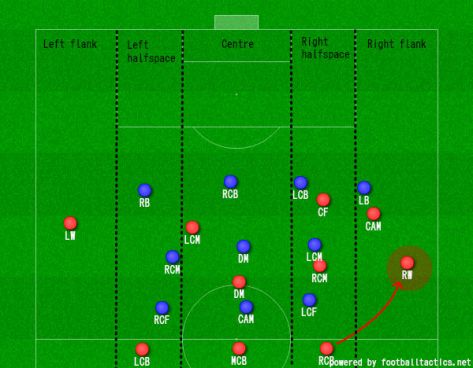
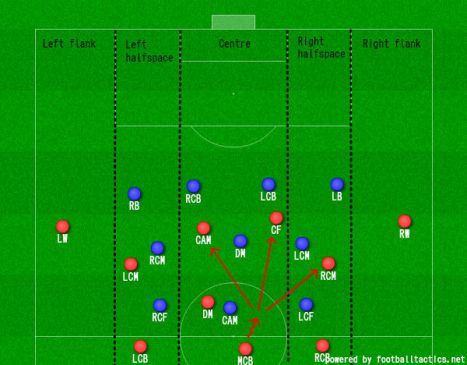
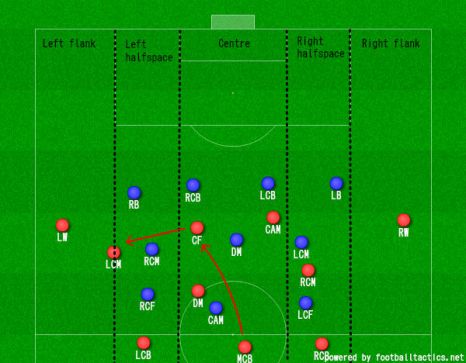
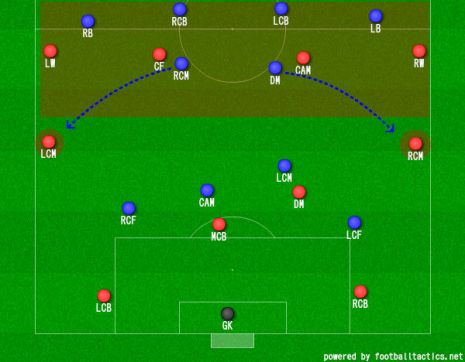
Positional Play vs. 4-4-2:
This was the most frequently used formation by Bayern’s opponents. BM’s basic idea was the same: to create 1v1s for the wingers. Therefore the wingers provided width all of the time, while the false-FBs task was to create a link towards them. The FBs stayed in the halfspaces, from where they were able to help the ball circulation at the back, plus they had better passing angles, as they had great access towards both the centre and the flank. Advantage of using the false FB concept.
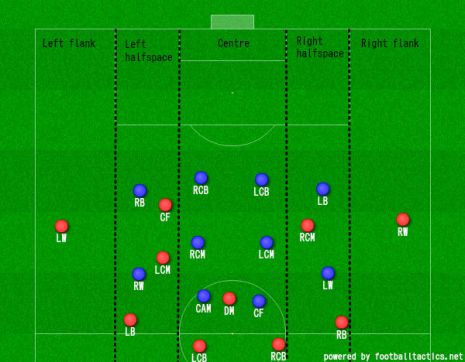
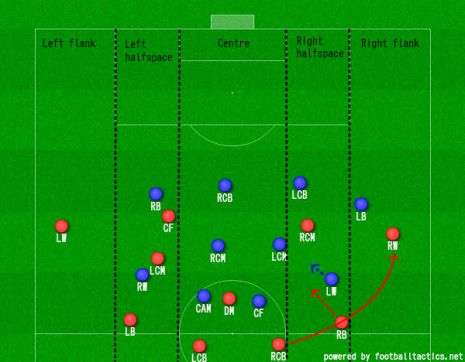
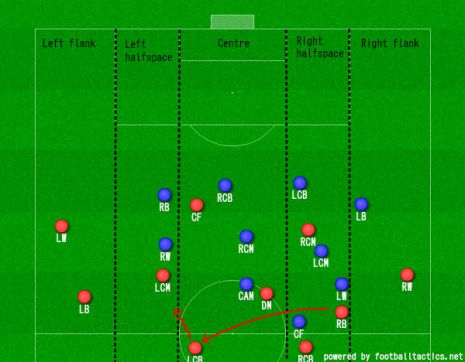
Creating a „3-men group” vs. a 4-4-2, which is basically overloading one side. Very effective against a 4-4-2, as in order to defend it well the midfield-line has to shift much, which would open up too much space on the far-side. If the RCB steps out to press, then the space behind him could be exploited with a through ball etc.
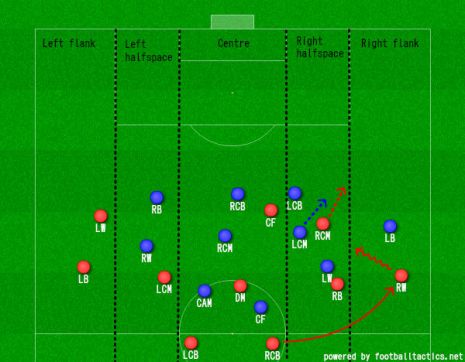
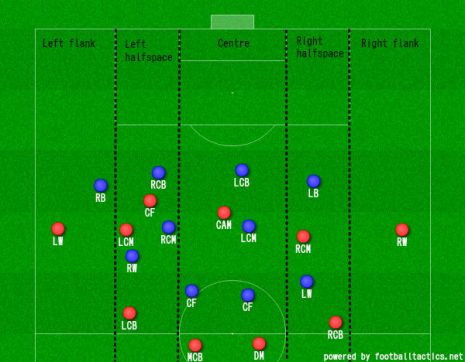
Same 3 CB-system, but now with a right-sided overload. As CAM drifts wide it creates a 4v2 situation.
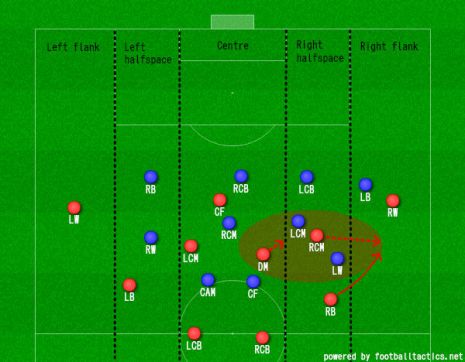
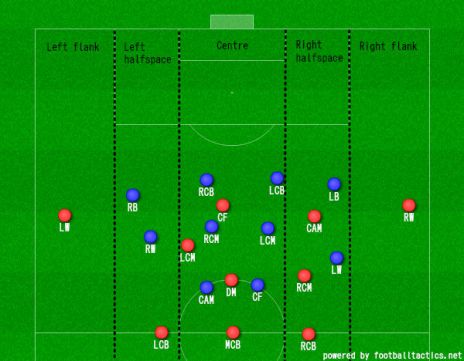
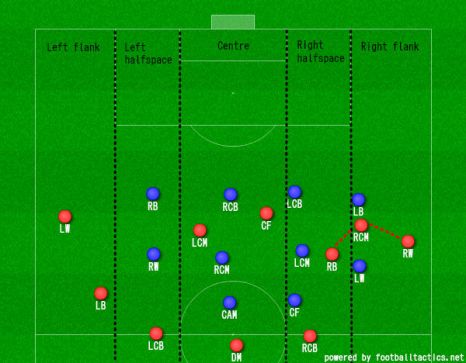
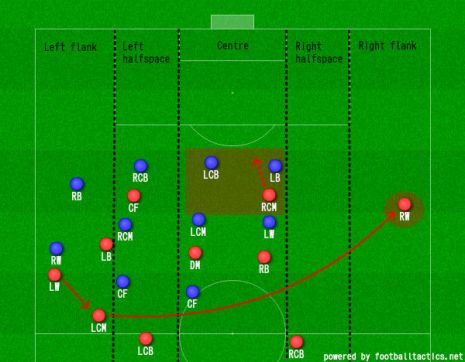
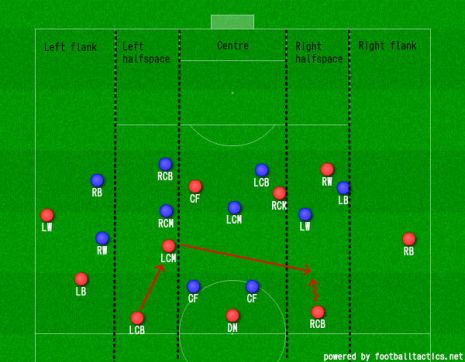
Right-sided overload vs. a 4-4-2, which opens up space for the DM. From here the DM is also able to make a horizontal rotation towards the far-side.
Positional Play vs. 4-5-1:
With the 5-men midfield, the 4-5-1 is able to defend verticality well, although at the same time it’s easier to circulate at the back. With wider CBs Bayern were able to pull out the opponent’s strong-sided CM, which was exploited well by the false FB from the halfspace.
LCM steps out to press the ball, with the false FBs it’s easy to exploit the space behind him. Of course in this situation LCB may step out to close down the RCM, although then it would open up space for the CF to run into.
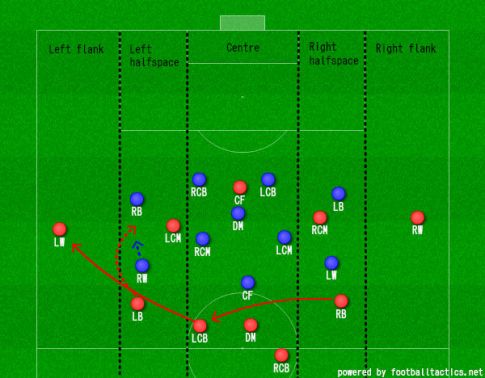
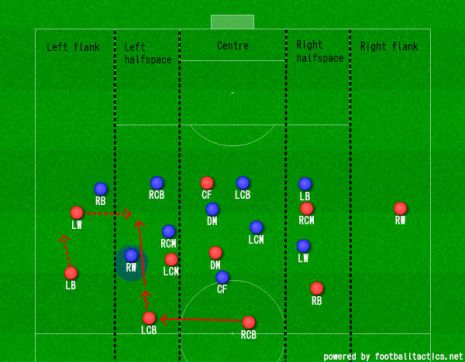
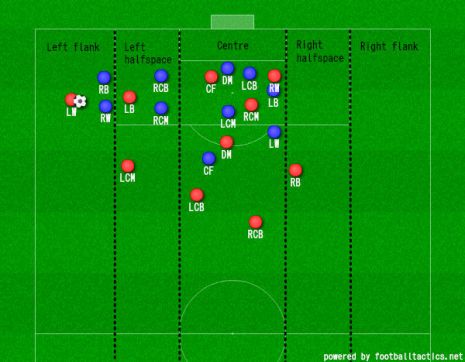
Positional Play vs. 4-2-3-1:
The 4-2-3-1 formation is a great shape to neutralize Bayern’s possession and the 2-3-5, as the 2 CMs may close down Bayern’s CMs in the halfspaces/centre, plus the front 4 is able to defend Bayern’s horizontal circulations. Although Bayern showed great movements, to break through the 4-2-3-1 defensive shape.
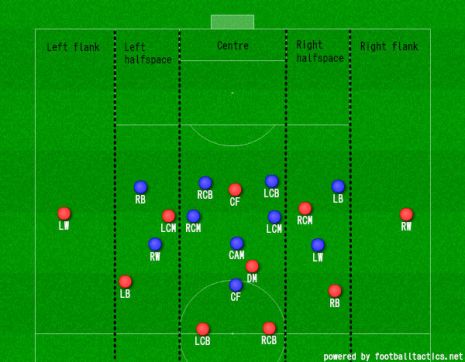
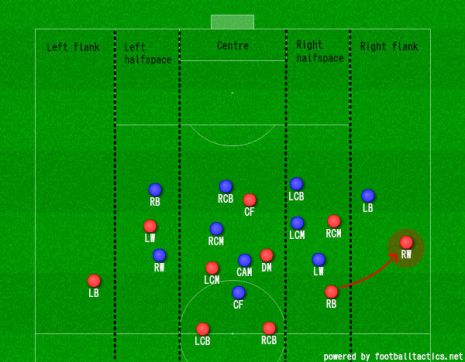
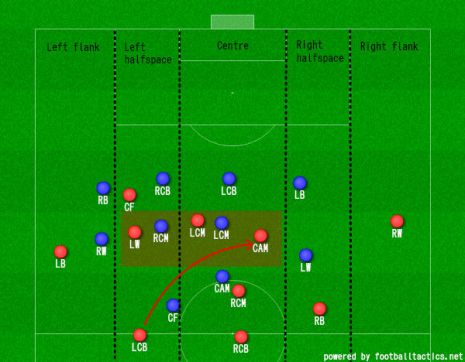
Positional structure vs. a deep 4-2-3-1 block.
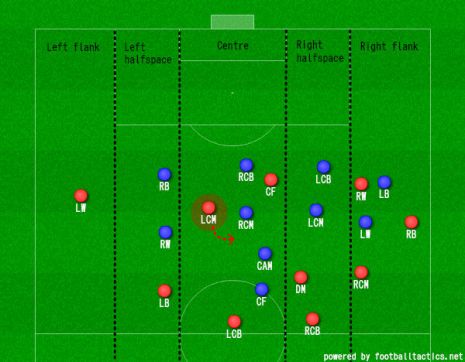
It was a frequent implementation that the RB moved inwards vs. a 4-2-3-1, to open up space for the RW on the right flank. This asymmetric shape basically created a right-sided overload, which was very effective: if the LW follows the RB, then easy pass to the RW. If LW doesn’t follow the RB, then RB is open, and may progress forward.
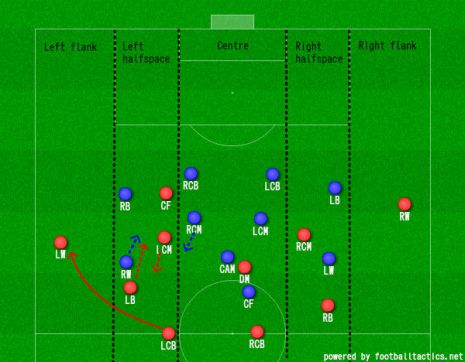
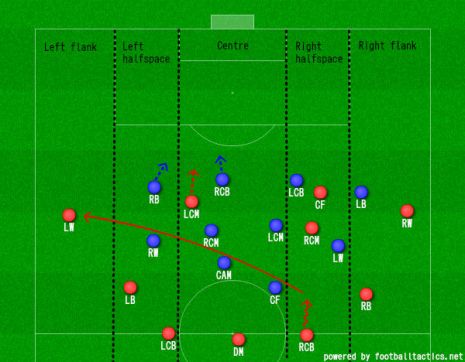
Build-up vs. a 4-2-3-1. With wide CBs it was a great shape to pull the opponent’s wingers out, which opened up space for the LB/RB. On the second picture the RB is in his more central position, which opened up space for the RCB, who may drive forward, making the build-up more fluent.
Positional Play vs. 5-4-1:
In the first half of the season, only this shape was used only 2 or 3 times against Bayern. Although since january, almost 80% of teams used this shape, as it looked the best to neutralize Bayern’s positional play. With the 5-men defensive-line Bayern couldn’t circulate the ball as effective as before, because this allowed the FBs to stay wide with Bayern’s wingers. The other advantage was that the wide defensive-line allowed the midfield-line to be narrower, which helped to neutralize the positive effects of the false full-back concept. Also, with a 5-men defensive line, it allowed the defenders to close down the attackers with aggressive man-marking (mostly after a successful vertical pass), because even if 1 defender leaves his positon, there are still 4 defenders left, therefore the positional structure stays in a balanced condition. Guardiola was suffering to find a solution against the 5-4-1, although after 3-4 matches Bayern showed much better penetrative movements.
Pressing in a 5-4-1 vs. Bayern’s build-up.
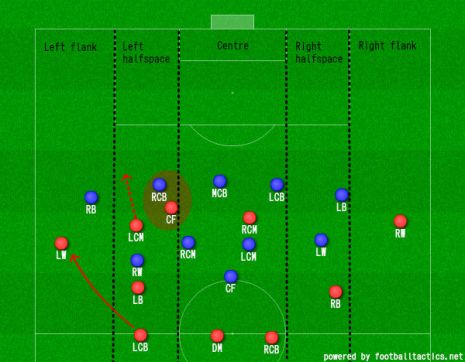
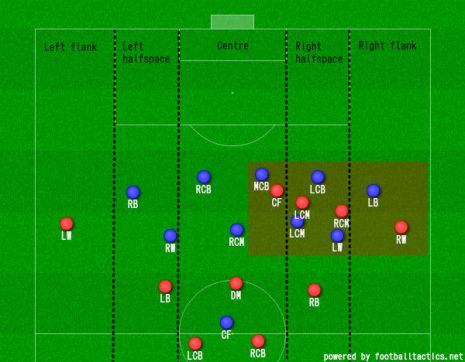
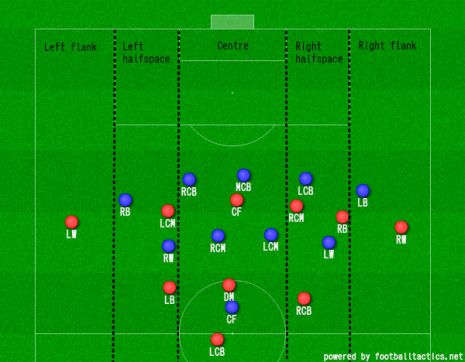
Vertical overload, as another solution. RCM and CF block his specific defender to open up space for the LCM.
Examples for horizontal circulation vs. a 5-4-1.
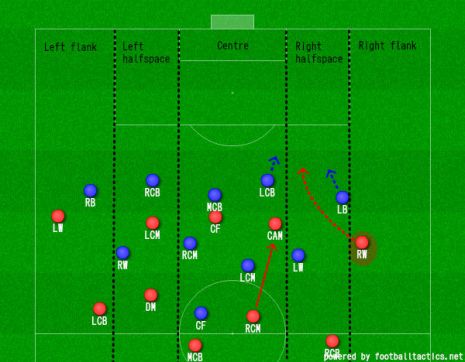
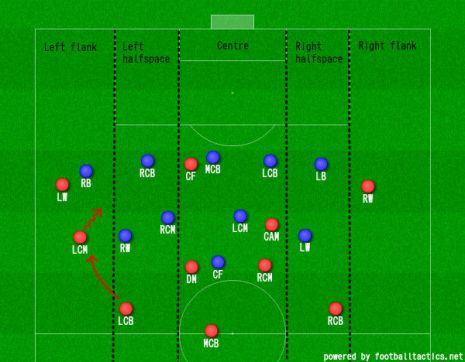
My favourite solution: the 4-0-6 offensive shape. The back 4 -with DM dropping- allows the constant horizontal circulation -plus positional structure still in balance-, while the up 6 provides enough vertical options, to help the penetration. Little emphasis on the central area, overloading the halfspaces and the flanks. Second picture is a great example of a left-sided overload, LB blocks RCB, to open up space for the CF.
Bayern Munich’s offensive game model:
- Centre-backs:
- main responsibility: controlling the ball circulation
- drive forward, when you have space in front of you -> then look for verticality/diagonality
- try to look for the far-sided winger, with a long diagonal ball -> to create a 1v1 for him in an advanced wide area
- don’t drive forward, when the DM is not in a situation, where he is able to drop into your position
- when the RB moves higer, the RCB may drift a little wider, to provide width in a deeper area -> helping the circulation
- build-up movements
- when you are pressured by the CF (who cover shadows the other CB or DM) then look for the CM, who then can pass to the CB/DM
- when you are pressured by the winger (who cover shadows the CM) then look for the FB
- when you are pressured by the winger (who cover shadows the FB) then look for the CM, who then can pass to the FB
- Full-backs:
- position yourself into the halfspaces, to maintain a great connection with both the CBs and the wingers
- also, this positioning is harder to press, as the your great connection allows you to look for both centre and the flank
- when the winger on your side moves inwards into the halfspace, then move outwards towards the flank, to provide width
- when you notice, that the winger on your side has the opportunity to have a 1v1 situation, move higher in the halfspace
- with this you indicate to him to drop a little deeper -if needed-, as you are about to open up the direct passing lane towards him
- when the winger has the ball on the flanks, and you are higher in the halfspace, then make an underlap run, to open up space for the winger, so he may cut diagonally inside
- as it stretches the opponent’s defensive shape
- when the ball is on the other side, move to the border of the centre/halfspace
- to maintain a better connection with the CBs
- Defensive-midfielder:
- when a CB drives forward, always drop deep to his position -> maintain the balance in the positional structure
- when a FB moves higher in the halfspace, drop deeper, to provide stability
- when a CM gives defensive depth support for the FB -who is on the flanks-, then stay in the centre, to maintain the connection with the other side
- when a FB does not have defensive depth support, then move to the halfspace, to give support
- in a 3-CB system stay in front of the MCB -so mostly in the centre-, try to give him diagonal support -> drop, when the circulation is passive -easier to stretch with a 4-men backline
- vs. 4-4-2 stay between the 2 CFs, to force them to a narrow positioning
- when the team gets isolated on the flanks -strong-sided winger, CM, FB and CB are all closed down- and the FB has the ball, make a lateral run towards the ball, to open up the passing lane towards the far-sided CB -if you are not followed, then easy pass towards you
- vs. a deep block stay in front of the 2 CBs, mostly in the centre -> balance in the positional structure
- Central-midfielders:
- when you are the far-sided CM, drop a little, to maintain the stability in the structure
- position yourself between the opponent’s CM and winger in possession
- between the lines
- when the winger has the ball make an underlap run, to open up space for him
- when the LB moves higher, the LCM should drop -> don’t do it if RB moves higher, because of the intentional asymmetric shape
- when LB-RB has the ball vs. a 4-4-2, and the wingers are closed down by wide FBs, then drift wide to stretch the opponent’s midfield-line -> triple-width
- when a player has the opportunity to rotate to the far-side with a long diagonal ball, then make a run between the FB-CB to open up space for your teammate on the flank
- don’t move too much in possession, wait in position until you get the ball -> constant space occupation
- I read in an interview with Xabi Alonso that Pep Guardiola coaches players in great detail. One example was him telling you “Mario, just stand still. The ball will come to you.” Are you still learning new things at your age under that kind of manager?Gotze: Absolutely. There’s a lot of things you can still learn. When you’re young, you always want the ball, you run a lot into spaces. At first it sounds strange to you that someone says ‘Stop running, wait for the ball,” but it’s one of many things that you can and should learn. It’s part of my development.
- Interviewer: Is it important to you that players can interchange the position they play in?Pep: I like to (inter)change. We need intelligent players to know when to change position, when another player you know can use this position. I like it more when the ball goes to the position of the players more than the players moving a lot. So maybe in the future the players can understand better what we’re looking and for the natural way they (inter)change but in the beginning it’s better to stay in the position and try to move the ball as quick as possible and go to the positions where you have the players.
- drift wide vs. a 4-3-3 when the RCB/LCB has the ball, plus even at build-ups -> stretching the opponent’s defensive shape
- move to create a vertical overload vs. a 5-4-1
- when both the FB and the winger are in an advanced wide area, drop to the halfspace, to give them defensive depth support
- Wingers:
- always stay wide to provide width
- when the FB makes a vertical move -moves higher in the halfspace- drop a little deeper, to give support -> better angle for a direct pass
- when a CM/FB makes an underlap run and they are closed down well, then try to cut insdide, as the underlap run opens up space diagonally for you
- try to look for diagonality, when you cut inside -> as it opens up diagonal passing lanes
- when the opponent’s FB follows you, move inwards to open up space for your FB -> in the circulation
- when the ball is on the other side in front of the box -vs. a deep block- then move inwards, and try to arrive for the cross
- when the CM makes the triple-width movement, move a little higher to open up space for the CM
- always make the 1v1, when you have the opportunity
- Centre-forward:
- drop and move to create the 3-men group vs. a 4-4-2
- position yourself between the CB-FB to open up space for the winger on the flank
- preferably don’t make the underlap run, only if someone has already taken your position
- most of the time try to drift towards the ball, to make overloads
- help the vertical overload vs, a 5-4-1 -> block a CB
- vs. a 4-4-2/4-2-3-1 try to offer yourself for a vertical pass in the centre
- when you receive a vertical pass try to immediately switch towards the flanks
- if you have space to face the opponent’s goal, then turn, of course
Defensive organization:
Basically Bayern Munich’s defensive formation was a 4-1-4-1. This provided them great flexibility, as from here it’s easy to change to a 5-4-1 -with DM dropping into the defensive line- or to a 4-4-2 -with a CM stepping up to press, DM takes his position. What’s essential here is the flexibility. The DM stays directly in front of the defensive line, which allows the CBs to follow their attacker, knowing that the DM is able to drop and fill in their position. Although their defensive organization -in the classical sense- could be observed very rarely, because when they didn’t have the ball, they were pressing high, to get the ball back as soon as possible.
Basic situation vs. a 4-4-2/4-2-3-1. Firstly with a narrow shape -closing down verticality- they were able to force the opponent’s into wide areas. With ball-oriented shifts the opponent’s had no diagonal/vertical options, so they were forced backwards. That’s when the pressing movement starts usually, the first backward pass is the pressing trigger. Key here to offer the chance to pass backwards or laterally, to be able to press then. Another key is DM’s positioning, who always closes down the strong-sided halfspace, to cut the opponent’s diagonal options, plus to provide flexibility for the CBs.
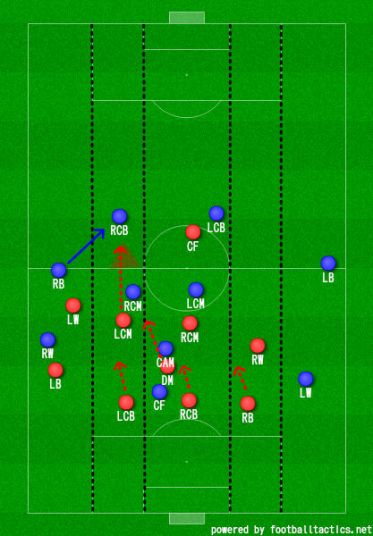
The 4-1-4-1/4-4-2 defensive system vs. 4-4-2/4-2-3-1.
The 5-4-1 defensive system.
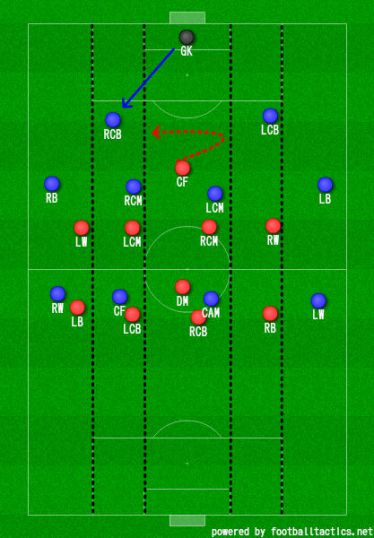
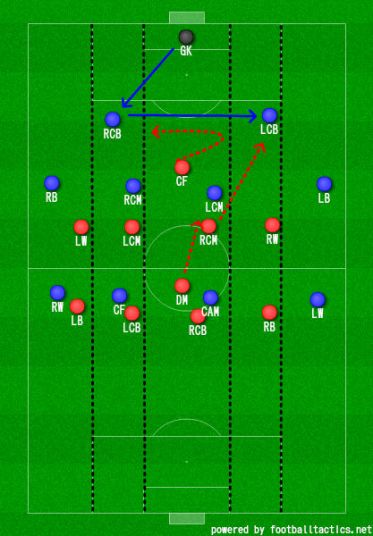
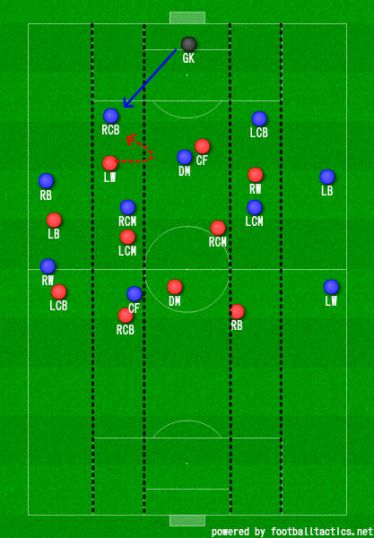
Pressing system vs. a 3-4-3/5-4-1. Here the DM drops into the defensive line, so LCB may leave his position, to close down the RW. Also important to highlight Bayern’s passing lane oriented pressing system. This -the passing lane orientation- is mostly used against teams, who try to possess the ball even at their defensive third.
Bayern Munich’s defensive game model:
- Centre-backs:
- when pressing, it’s you who define the height of the defensive line
- ideally the defensive line in a pressing situation should be about 5-8 metres from the halfway line, to keep the vertical compactness
- when the whole shape shifts towards the flanks, always be aware of keeping a proper distance between you and the FB on your side
- try to keep this distance about max. 10-12 metres (if the defensive shape is a 4-1-4-1, if it’s a 5-4-1, then less) -> to keep the horizontal compactness
- when there is a backward pass from the opponent immediately step higher, to decrease the available space for the opponent
- always follow underlap runs -> DM will drop into your position
- in a crossing situation, the strong-sided CB must always use zonal-marking
- DM/CMs will close down the cutback zone
- at defending goal-kicks the whole defensive line must drop, DM will go for the header, defensive-line must be behind him to give support
- when pressing against a 4-3-3, and the FB steps up to close down the opponent’s FB on the strong-side, drift wide to close down the strong-sided winger
- when pressing against a 3-4-3 the FB will close down the opponent’s FB, so you must close down the winger, follow him, even if he drifts wide
- when pressing, it’s you who define the height of the defensive line
- Full-backs:
- when pressing against a 4-3-3, always look for the winger’s movement on your side
- if he steps out to press the CB, then you must step up to close down the FB
- when pressing against a 3-4-3 you must close down the opponent’s FB
- use your cover shadow to close down the passing lane towards the halfspace/centre
- when you are the far-sided FB, move inwards at least to the border of the halfspace/centre, to keep the horizontal compactness
- never be too man-oriented, it’s better to leave the flank open, to force the opponent into a wide area, then starting the pressing movement
- when pressing against a 4-3-3, always look for the winger’s movement on your side
- Defensive-midfielder:
- at defending goal kicks you must be the one to go for the header, the defensive line will be behind you to give support
- when pressing in a 4-1-4-1 formation, always cover the strong-sided halfspace in front of the defensive line
- try to be as close to the defensive line as you can, to give support
- when pressing against a 3-4-3 always drop in between the CBs, to provide flexibility
- when pressing against a 4-4-2/4-2-3-1 always look for the CMs movement
- if one of them steps out to press, then take his opponent, and form a 4-4-2 shape
- at crossing situations stay closely in front of the defensive line to close down the cutback zone
- if the opponent have at least 2 attackers inside the box, then drop into the defensive line to create a numerical superiority -> then the CMs must close down the cutback zone
- Central-midfielders:
- when pressing and the CF’s curved run is not enough to force out a long ball, then step out to close down the other CB
- the DM will take your position behind you
- never be too man-oriented, especially on the far-side
- shift with the defensive shape, to keep the horizontal compactness
- at crossing situations you must be close to the defensive line, to close down the cutback zone inside the box
- when defending always drop to maintain the vertical compactness
- plus to offer a possible lateral passing lane, which is also a pressing trigger
- when pressing and the CF’s curved run is not enough to force out a long ball, then step out to close down the other CB
- Wingers:
- when pressing vs. a 3-4-3 you must move to close down the RCB/LCB
- the FB behind you will close down the opponent’s FB
- when pressing vs. a 4-3-3 step out to close down the CB, the FB behind you will close down the opponent’s FB
- when pressing and you are the far-sided winger, always move inwards to the halfspace, leave your FB, to maintain the horizontal compactness
- plus, if the cover shadow are used properly, there is no way that the opponent have the opportunity to switch to the far-sided FB
- use your cover shadow to close down the passing lane towards the centre/halfspace
- when you are the far-sided winger in a defending situation, always drop to close down the opponent’s possible vertical options, to force out a backward or lateral pass, which is the pressing trigger
- when pressing vs. a 3-4-3 you must move to close down the RCB/LCB
- Centre-forward:
- when pressing in a 4-1-4-1 let the GK to pass to a CB, then use your cover shadow to close down the other CB, to force out a long ball
- curved run
- when pressing against a 3-4-3 stay with the MCB
- if the CB passes backwards to the GK, continue the curved run to force out a long ball
- when defending drop deeper, and leave the opponent’s CBs open
- to maintain the vertical compactness, plus to cut their verticality, and force them backwards, then start the pressing movement
- when pressing in a 4-1-4-1 let the GK to pass to a CB, then use your cover shadow to close down the other CB, to force out a long ball
Set-pieces:
Corners
At offensive corner situations I have not analyzed their specific movements inside the box, although I would like to highlight an essential aspect. A lot of teams tend to forget to cover the centre and the halfspaces, therefore they concede a easy counters. If the opponent don’t have a player higher -so every player is inside the box- then 3 players is enough in front of the box, to protect these zones. If the opponent have at least 1 attacker higher, then there are usually 4 players deeper, 2 of them close down the attacker, while 2 stays in front of the box. Of course this may change against team, who counter well -if they do, then Bayern usually leave 4 players deeper.
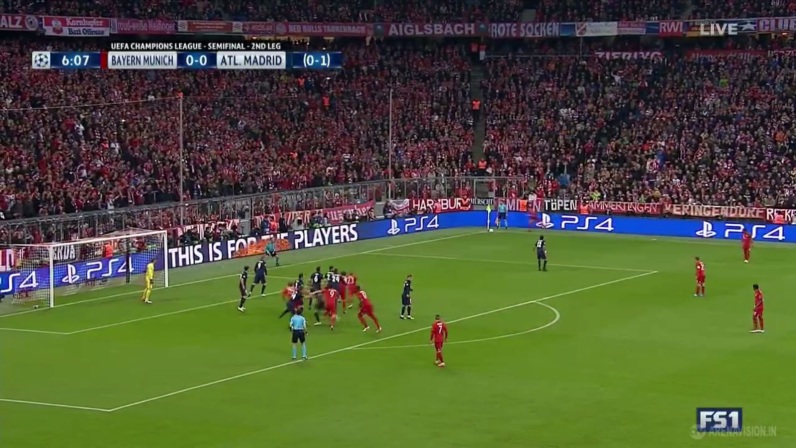
At defensive corners, Bayern used a full zonal-marking system in a 5-3-2 formation. This zonal marking allowed the player to focus on the ball for the full time, which helps the defending, because it is a proactive way to defend corners -not like man-marking, which is reactive.
Throw-ins
Most important here is the horizontal compactness. Without that the access towards the ball is not adequate, therefore it’s much harder to defend these situations -for example easy swtich towards the far-side for the opponent. Another essential aspect is to prevent any kind of horizontal switches, because then it would be easy to exploit the narrow defensive shape.
An extra
I have also analyzed some training clips. In these drills the aim is to practice the build-up phase, and to practice the movement of the defensive line. Enjoy!
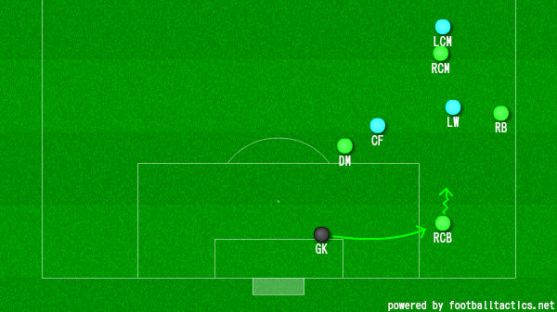
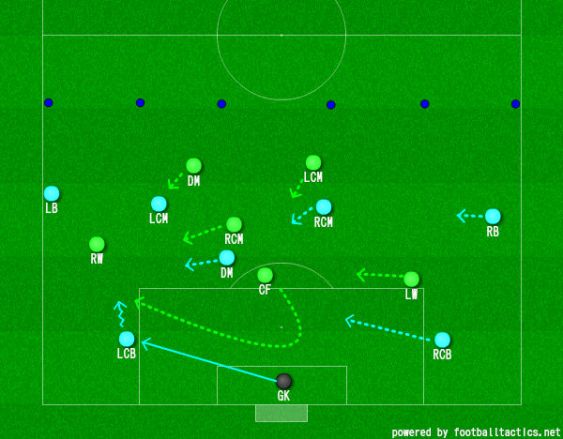
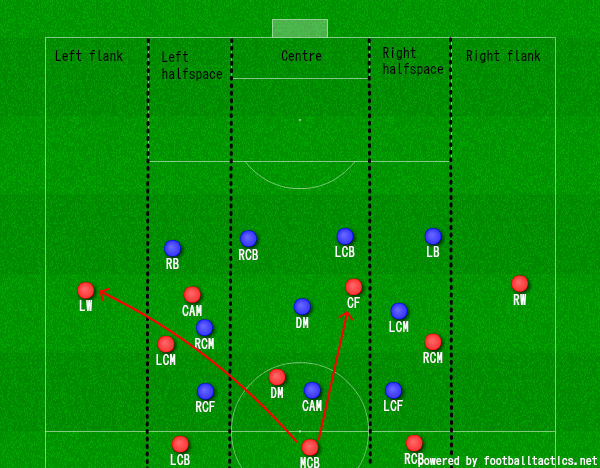
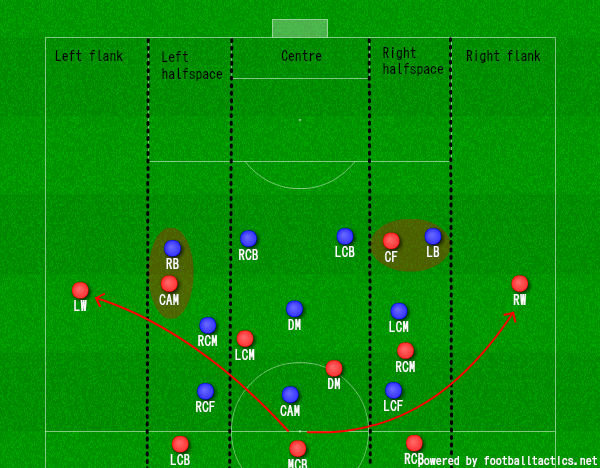


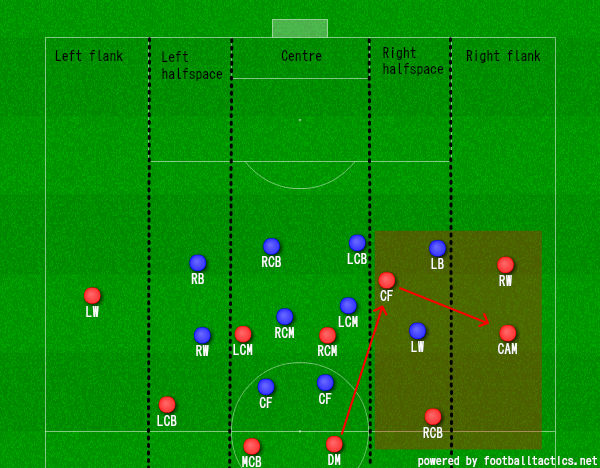
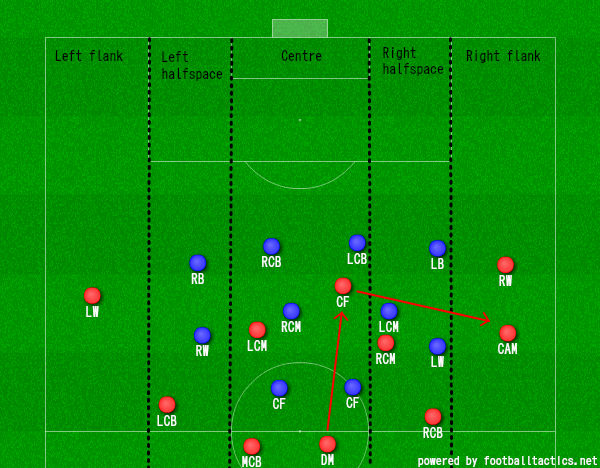
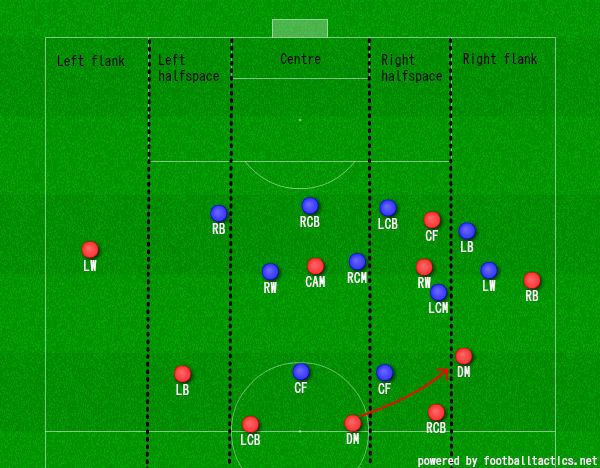

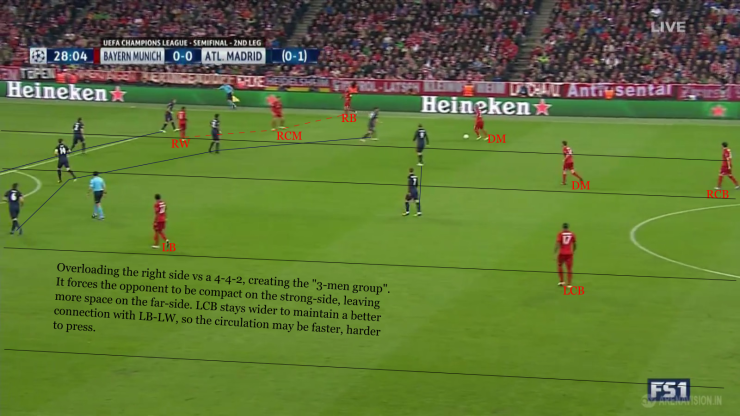
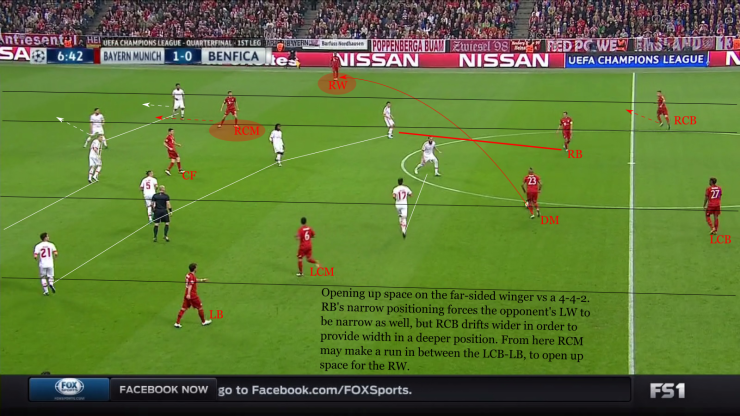
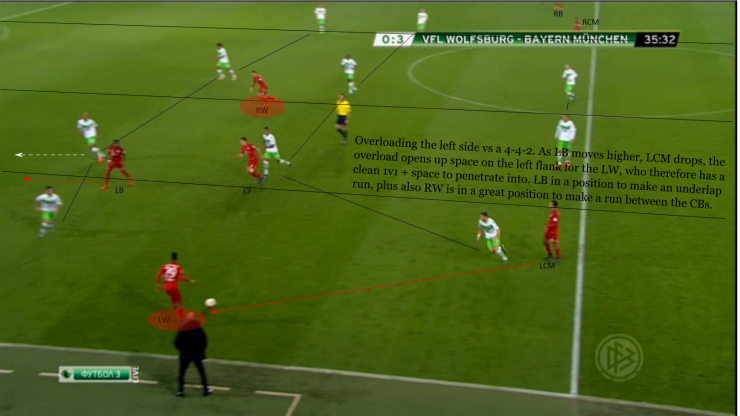
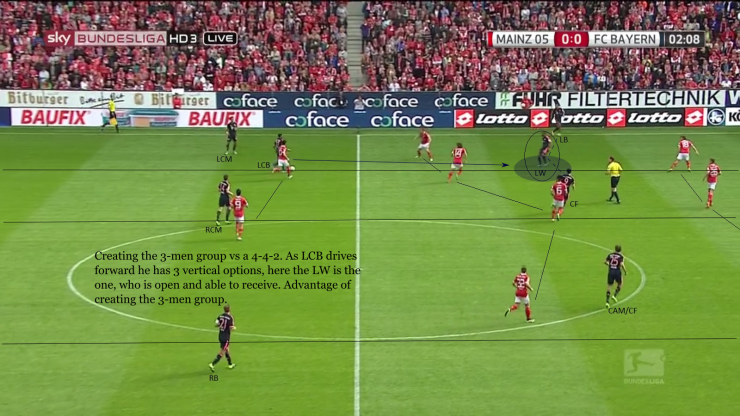


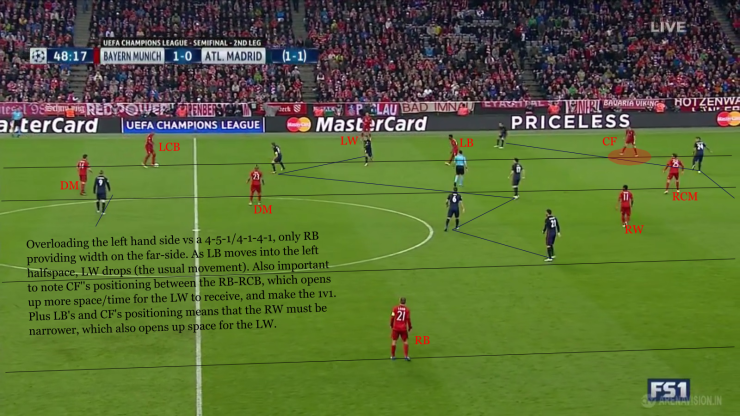
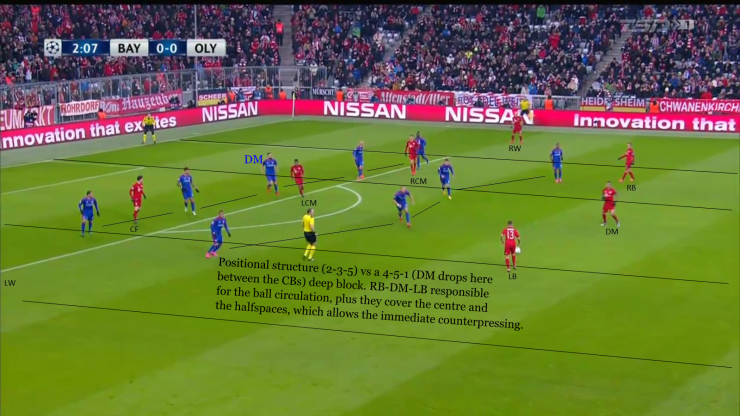
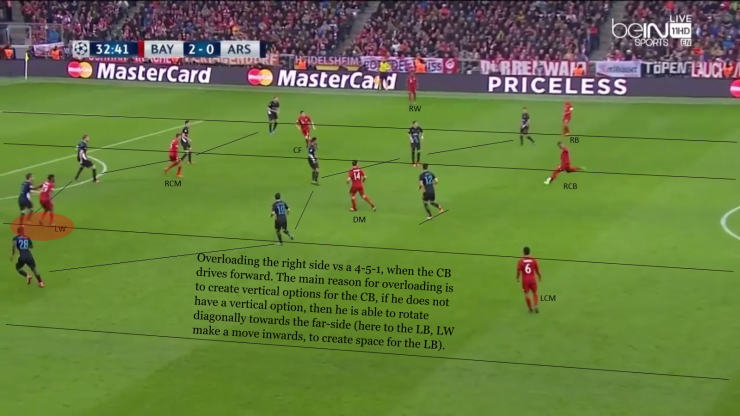
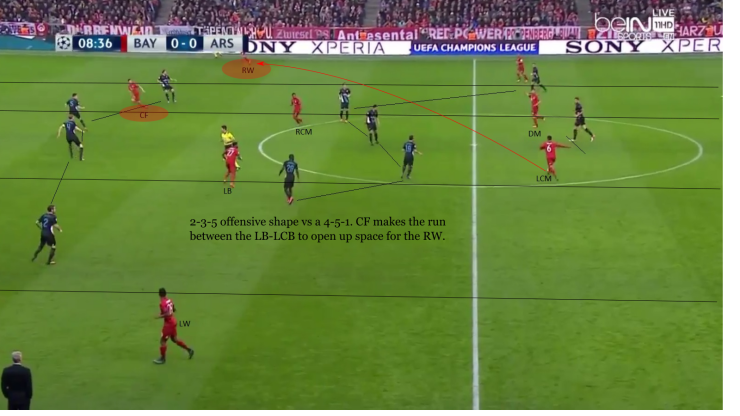
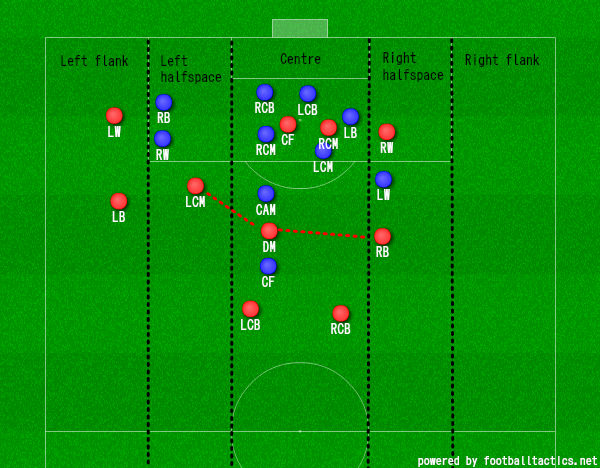
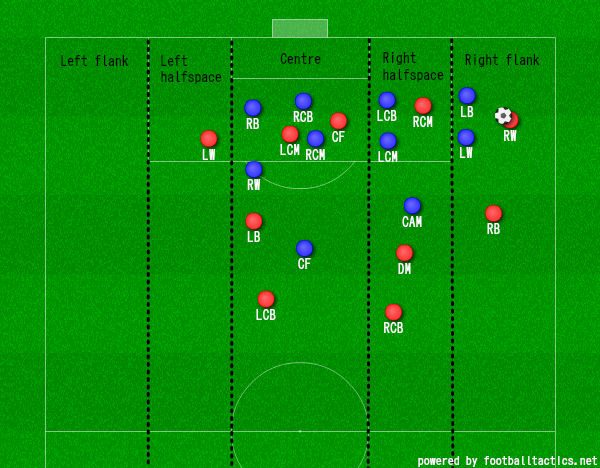
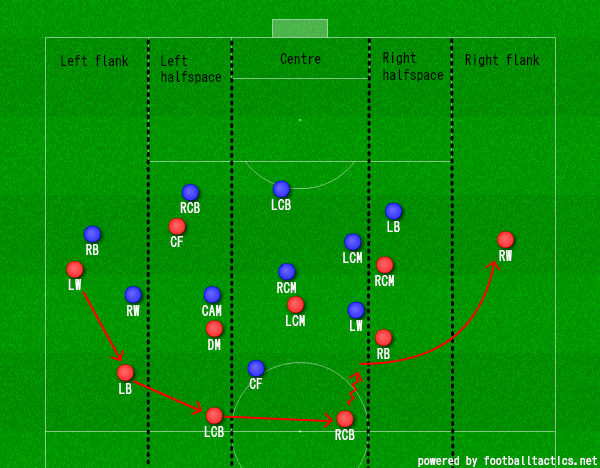
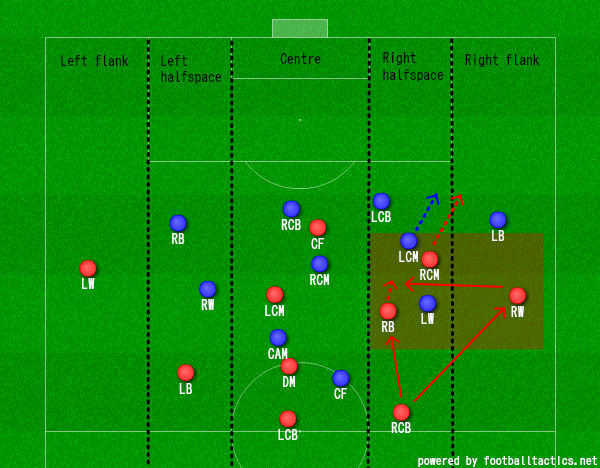
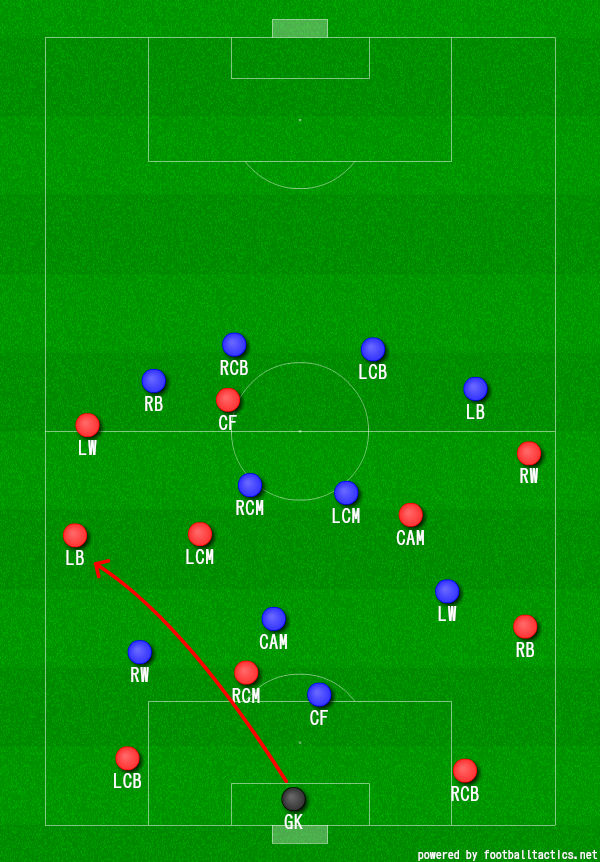
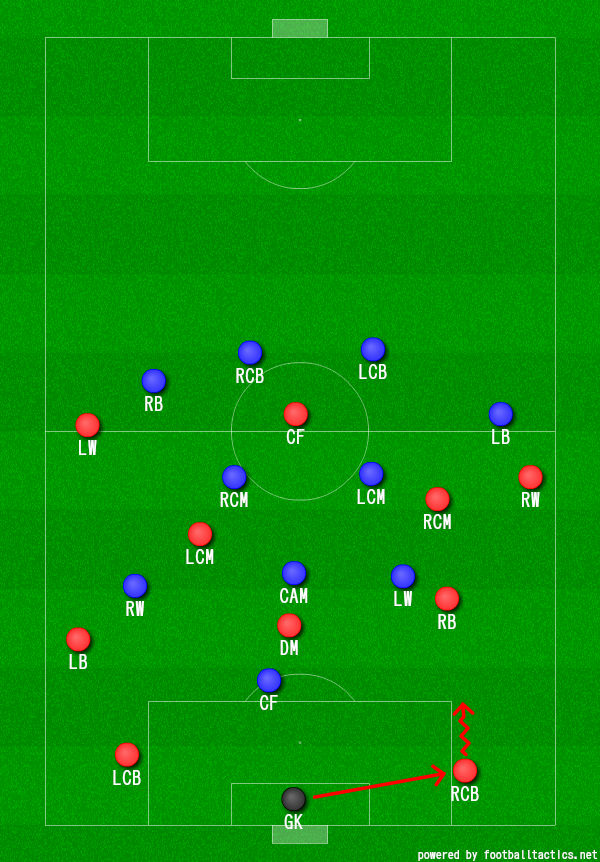
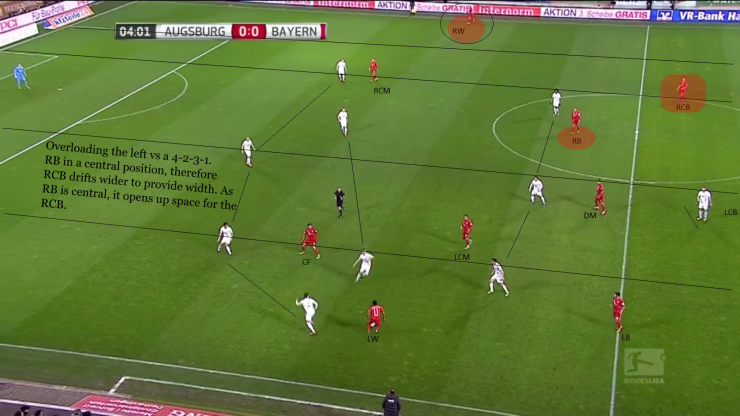
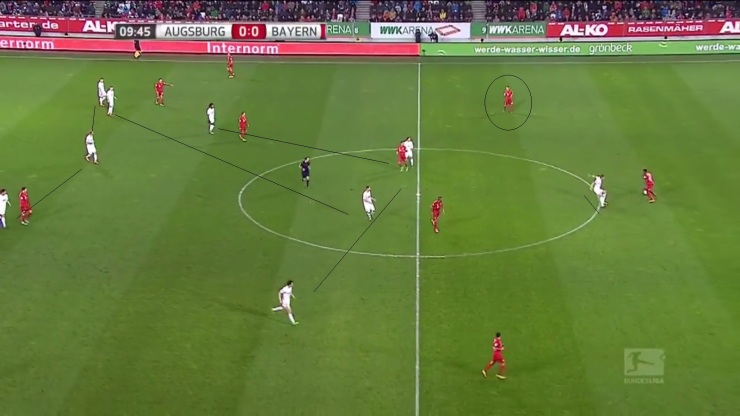
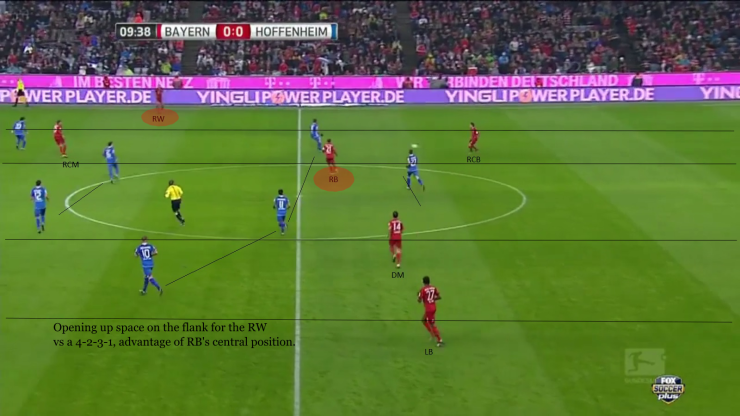
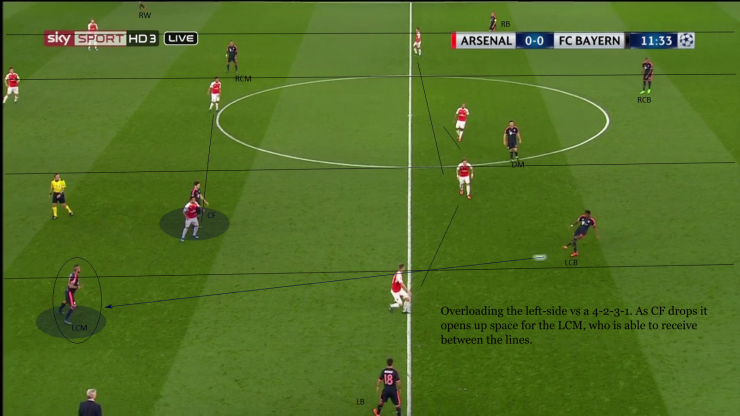
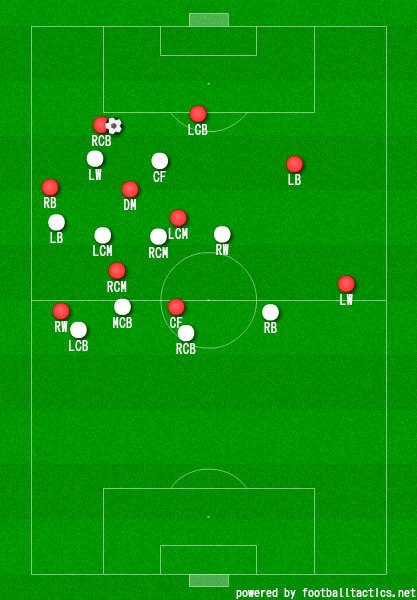

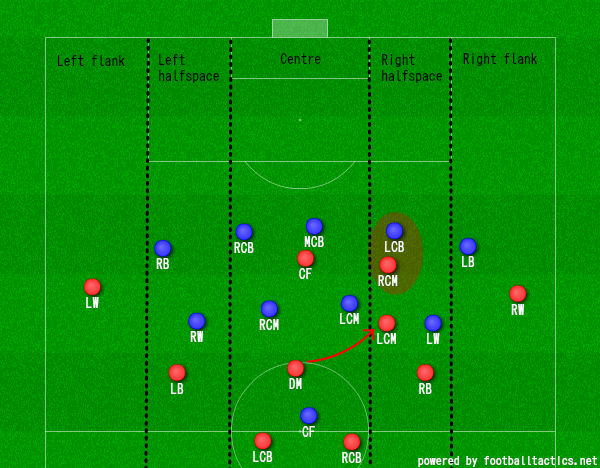
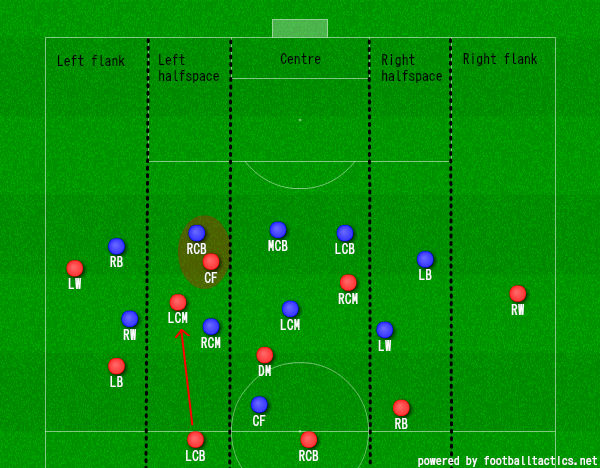
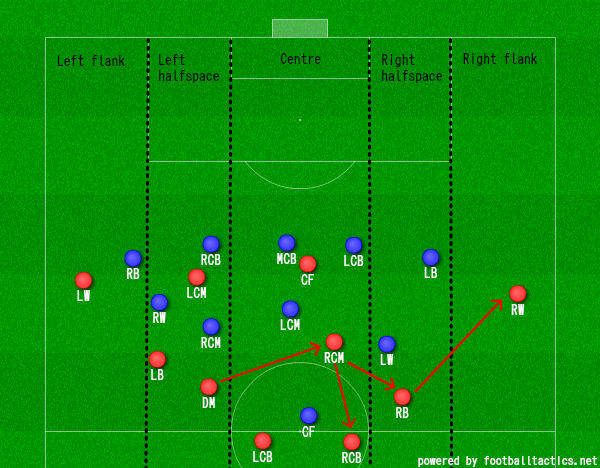
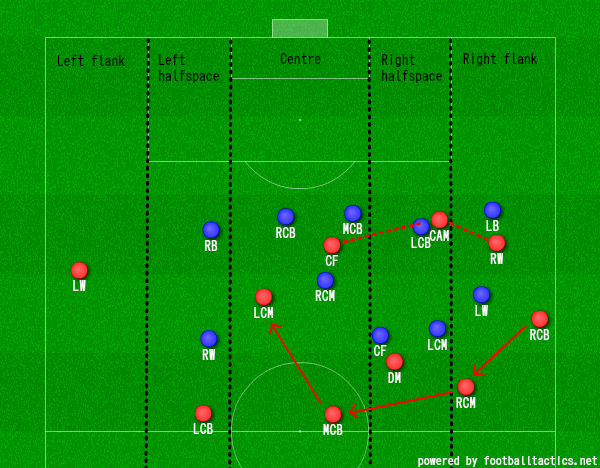
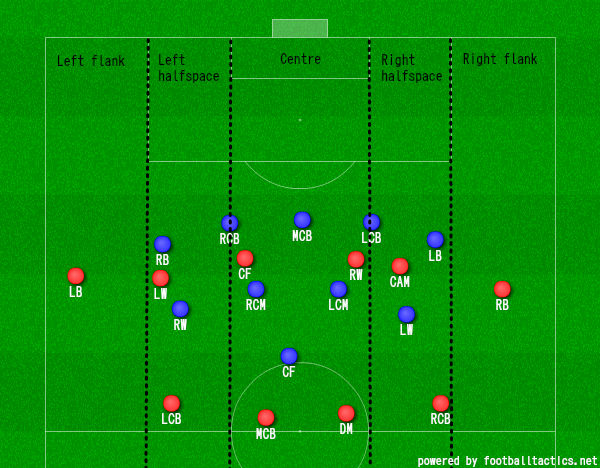
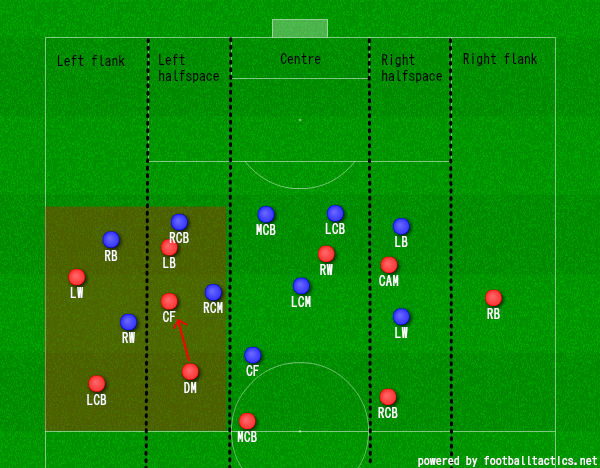
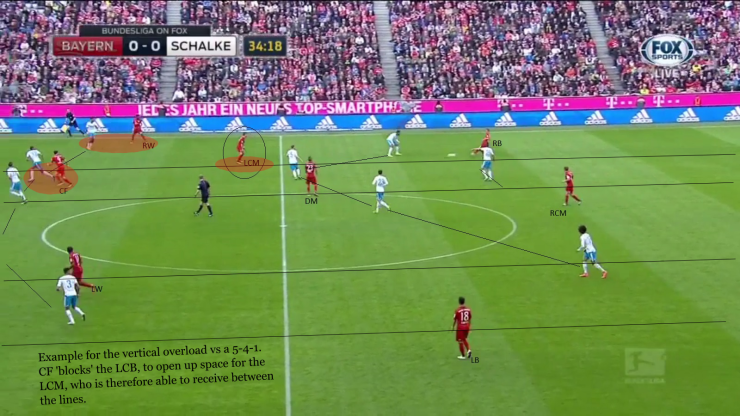
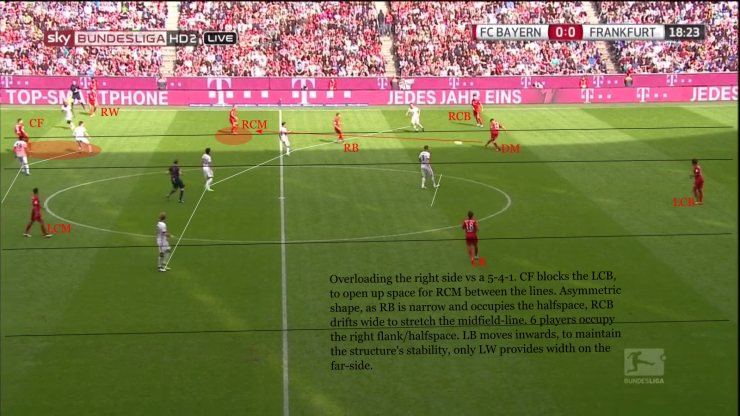
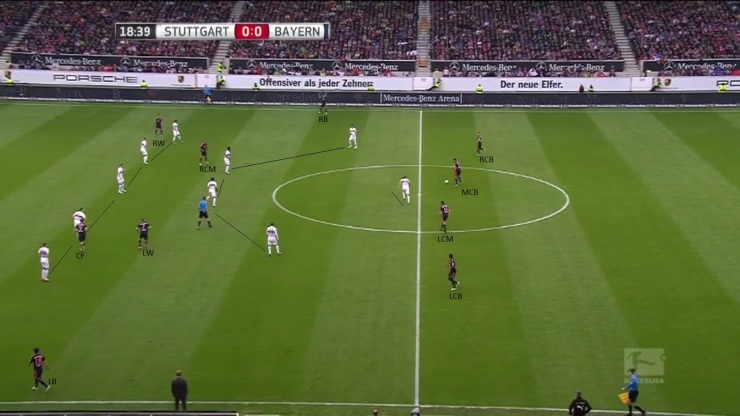
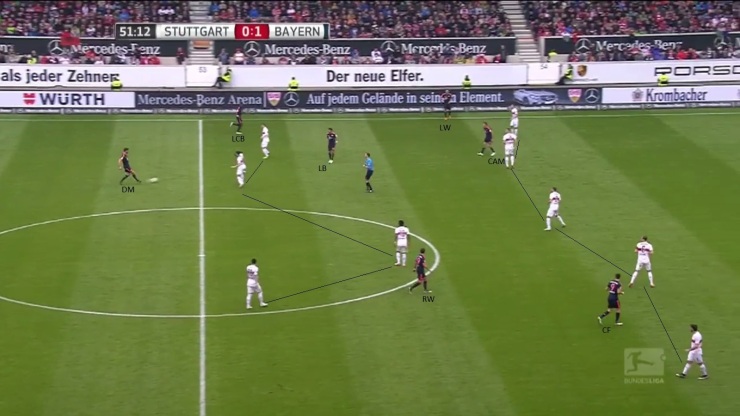

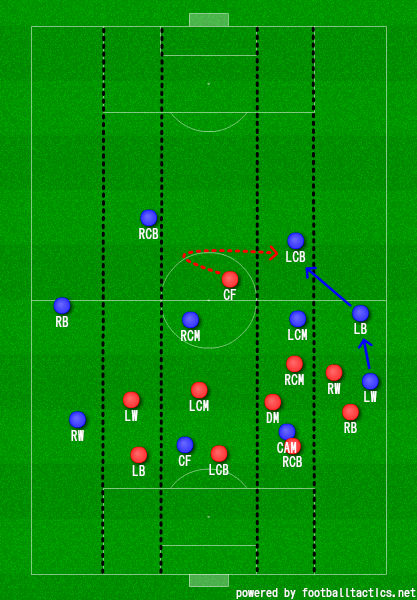
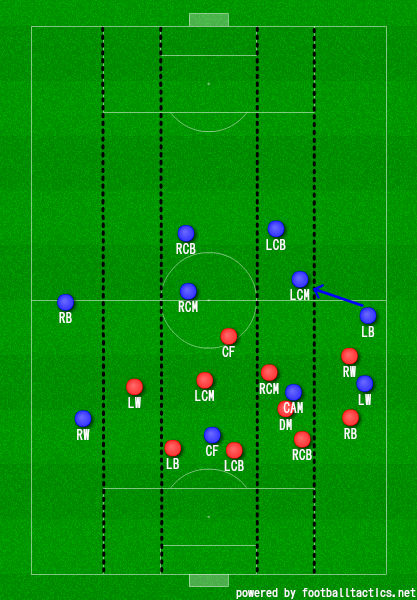





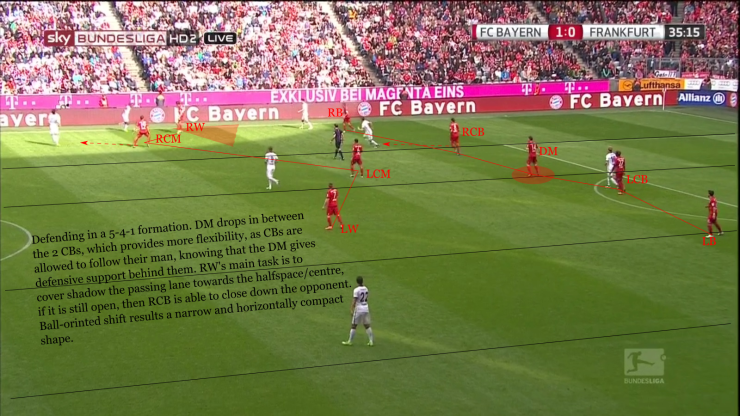
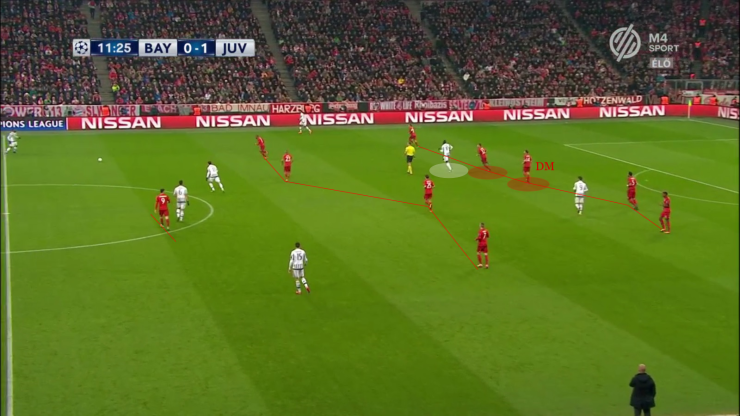

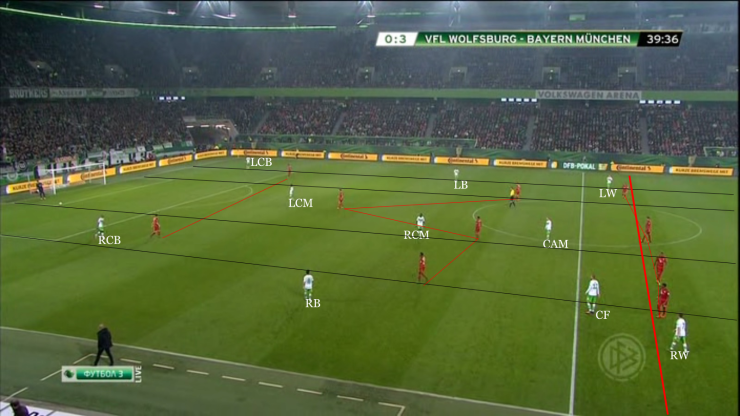
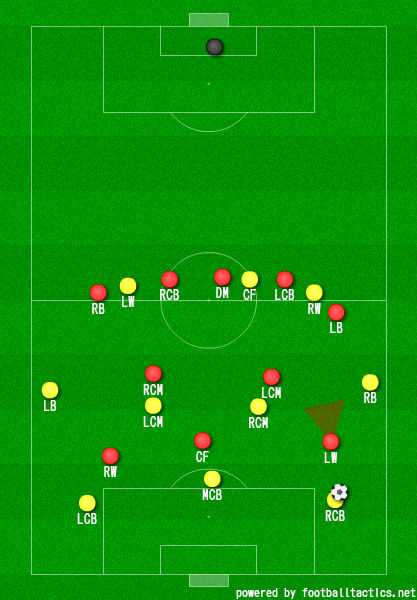

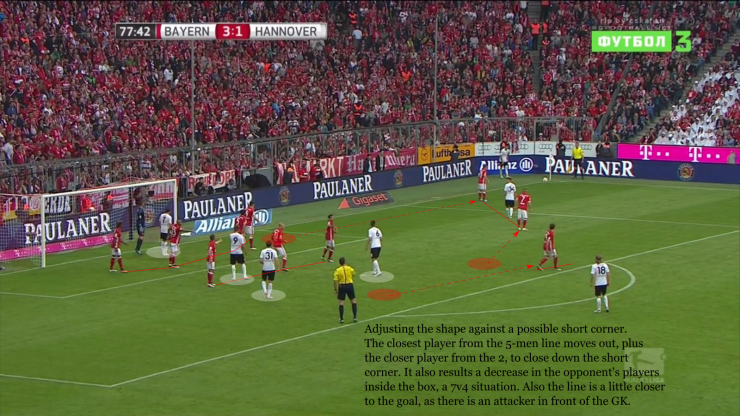
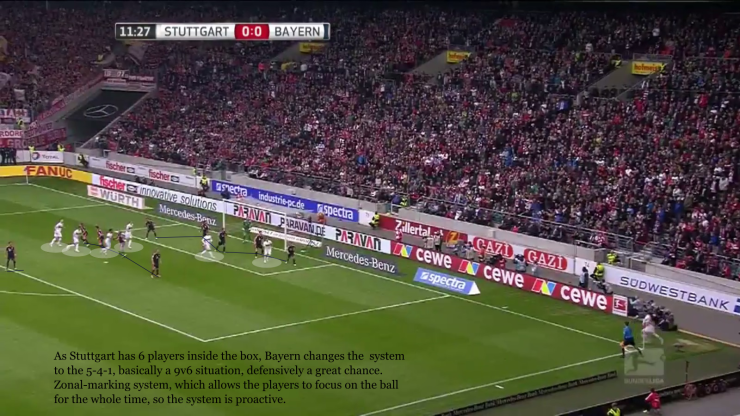
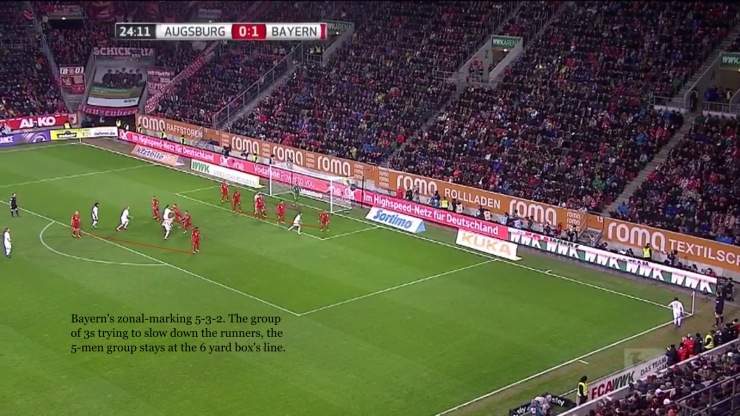
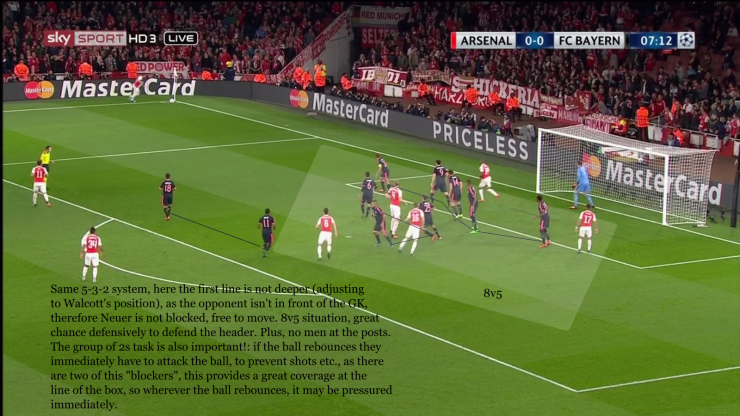

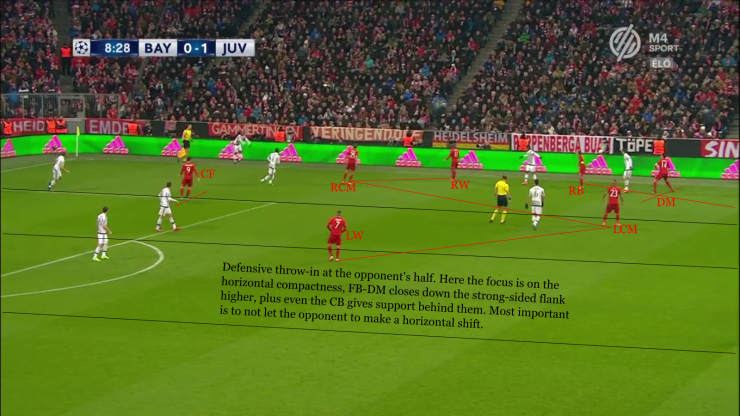

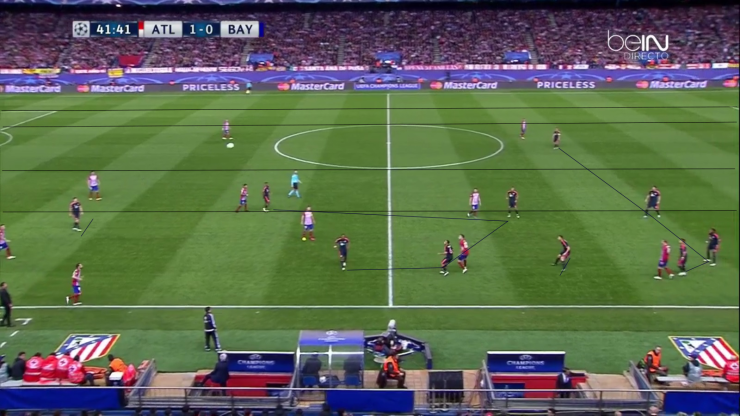
Amazing! Just wanted to commend your effort and quality. Keep up the good work!:)
LikeLiked by 1 person
Excellent! massive fan of yours and I love particularly this piece of work. Have to commend you for the level of depth you managed to bring but also being able to make it so accessible and easy to understand. Would be great to see more from his time in the PL and if Pep changes a lot. Thanks!
LikeLike
Do you agree that the centre and the half-spaces are the best spaces to conquer when a team is attacking? And what ways are the best to gain that space? For example, a forward makes a run to force the opposition defensive line to drop and put a pass between lines?
LikeLike
Absolutely agree. I would say constant circulation, if we are talking about a team, who uses the principles of positional play. But there are hundreds of ways to gain space, with little movements, for example the one, you wrote.
LikeLike
And for example a team that defend with 1 or 2 players between the lines to protect that space? For example a 4-1-4-1 or 4-2-3-1?
LikeLike
It always depends on the opponent’s shape of course. For example a key aspect vs a 4-2-3-1 is to stretch the 2 CMs, to open up space in front of the defensive line.
LikeLike
Once i heard that the most lethal and best weapon in Guardiola Barcelona was to use the ball as a bait, for example put the ball in a very occupied space, force the opponents players to narrow and then take the ball out of that space and utilize the space that was empty because of the narrowing of the opposition players to make some of the ball movements to the back of the defensive line.
LikeLike
I think so, the halfspace is the best place for diagonal passes that’s why teams try to create this space
LikeLike
Do you agree that the centre and the half-spaces ate the best spaces to conquer when a team is attacking? In what movements,combinations, in what ways can we conquer that space? For example say to a forward to make a run to force the opposition defensive line to drop and put a pass between the lines? Love you blog and your post.
LikeLike
Or a lot of one-two passes that Guardiola Barcelona used a lot to break opposite defensive lines.
LikeLike
Excellent in depth analysis….it will be interesting to see his transition from bayern to city….games against the likes of stoke and west harm will be pleasant to analyse.
LikeLike
Amazing work
LikeLike
Thank you for your excellent work. Please keep it up;
LikeLike
Perfect work one of the best i read so far congrats for your great work
LikeLike